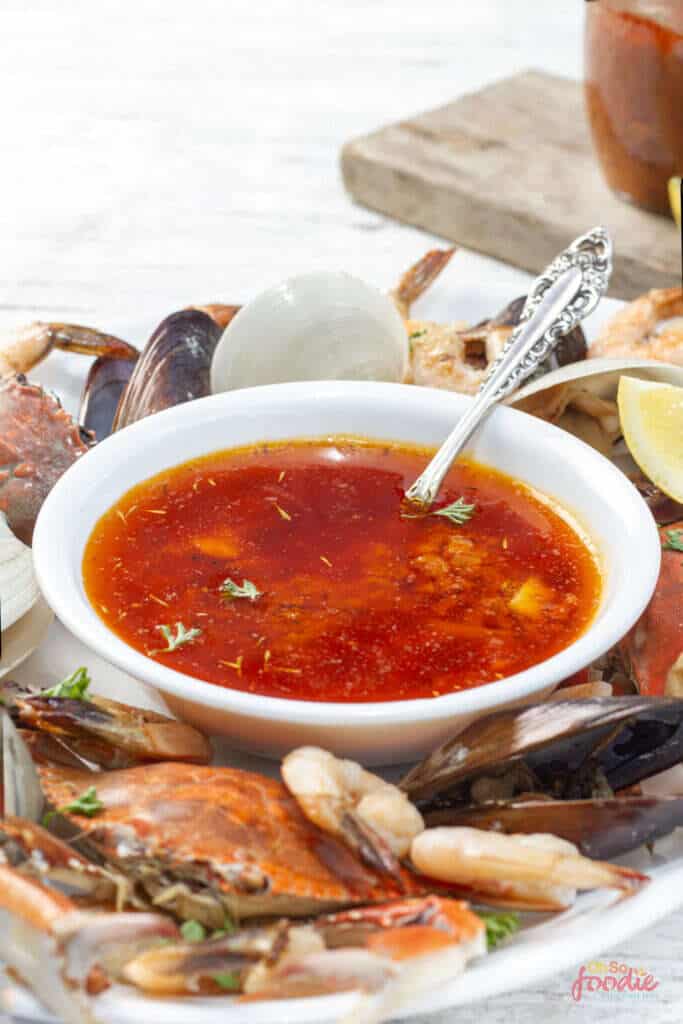Last Updated on January 2, 2024 by Toya
Have you ever made a seafood boil sauce that wasn’t as thick as you wanted and wondered how to make seafood boil thick? Here, I’ll show you a few easy ways you can thicken a seafood boil sauce in no time!
Seafood boil sauce is one of those sauces that is flavorful, aromatic, and used to enhance the taste of many seafood boil recipes.
The exact ingredients and proportions of a seafood boil sauce can vary depending on regional preferences and personal tastes, but it generally includes a combination of spices, herbs, citrus, a seafood seasoning mix, butter, broth, salt, pepper, and minced garlic and onions.

To make a great seafood boil sauce, you would typically mix these ingredients together in a pot, heat them up to fuse the flavors, and then pour that flavorful sauce over your seafood boil recipe, or use it as a dipping sauce. Because I enjoy seafood boils so much, I’ve made quite a bit of seafood sauces such as my go-to seafood boil sauce, my buttery crab boil sauce, or even my rich shrimp boil sauce and they’ve all turned out great. But if you want some ideas on how to thicken them up this post will help you out.
Keep in mind that there’s no strict recipe for a seafood boil sauce, so you can adjust the ingredients and quantities based on your preferences. This type of sauce is a versatile component of a seafood boil that adds a lot of character to the final dish and the thickening methods below show you just how versatile this sauce really is!
Let’s see exactly how to thicken a seafood boil sauce easily.
How to thicken seafood boil sauce
Thickening a seafood boil sauce can enhance its texture and help it cling better to the seafood and other ingredients. Here are five common methods for anyone looking to thicken a seafood boil sauce recipe.
Roux: A roux is a mixture of equal parts fat (such as butter) and flour that is used to thicken sauces and soups. To make a good roux, grab a pan and melt the butter, then whisk in an equal amount of all-purpose flour until it forms a smooth paste. Cook this roux for a few minutes to get rid of the raw flour taste. Gradually whisk the roux into your simmering seafood boil sauce and cook until the desired thickness is reached.
Cornstarch Slurry: Mix cornstarch with cold water to create a slurry. For every tablespoon of cornstarch, use about one tablespoon of cold water. Stir the slurry until smooth, then slowly add it to your simmering seafood sauce while stirring constantly. The heat will activate the cornstarch and cause the seafood boil sauce to thicken up nicely. Cook the sauce for a minute or two to get rid of any cornstarch taste.
Potato Flakes: Potato flakes can be used as another great thickening agent for a seafood boil sauce. Gradually sprinkle potato flakes into your simmering sauce towards the end of the cooking time while stirring. Allow the sauce to cook for a few minutes to thicken up.
Reducing the Sauce: One simple way to thicken your seafood boil sauce is to simmer it uncovered for a longer period. As the sauce reduces, the water content evaporates, and the sauce becomes thicker. Be cautious not to reduce the sauce too much, as it might become overly concentrated and too salty.
Pureeing Ingredients: Another way to achieve a thick seafood boil sauce is by pureeing some of the ingredients in the sauce. Using a blender puree your onions and garlic and then mix this into the pot. This will help thicken the sauce while maintaining the flavors and textures of the overall sauce.
There are several effective methods to thicken a seafood boil sauce, and each offers its own unique pros and cons. Nonetheless, if you’ve made a seafood boil sauce that you want to make thicker, these methods provide options for achieving the desired consistency while maintaining the flavors of your sauce. From traditional techniques like roux and cornstarch slurry to creative approaches like using potato flakes or pureeing ingredients, the choice of thickening method depends on personal preferences and the specific flavors you want in the final sauce.